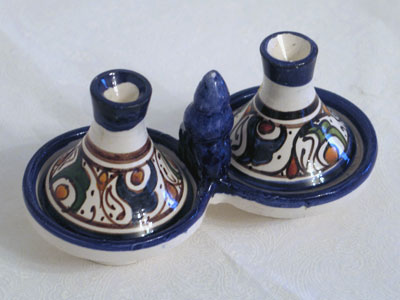Although the Moroccans are not as interested in food art as say, a group of New York urbanites, they have their own methods and artistry in cuisine that is both delectable and architectural.
The typical Moroccan food fare is laden with vegetables, couscous and usually some form of meat (either chicken, goat, or camel if you are daring enough). A quintessential form of cooking these ingredients lies in the volcan0-looking ceramic dish known as the tagine.
You’ll find the pottery of the tagine in almost every market stall you come across, whether it is in its large cookable form, or in a pair of mini tagine salt and pepper holders.

I was lucky to take a tour that included a ‘Make Your Own Tagine Day’. We were divided up into different groups by our main dish. There was a chicken tagine group, goat tagine, beef tagine, and then a vegetarian tagine group that I was a part of.
Tagine can involve any meat and vegetable combination. But chicken is one of the most common. Tagine is much like the pot roast of Morocco. It is a dish that requires a bit of seasoning and chopping beforehand, but then once it starts to cook, all that it requires is a bit of patience. Fortunately for us, there was a very picturesque valley far away from our delicious tagines that provided a two-hour walk and lots of pretty photos.
 By the time we returned and our tagines had been cooking on the stove for 1.5 hours, the vegetables were well-seasoned with cumin, cinnamon, salt, pepper and tumeric.
By the time we returned and our tagines had been cooking on the stove for 1.5 hours, the vegetables were well-seasoned with cumin, cinnamon, salt, pepper and tumeric.
YUM! Bright and beautiful vegetables, cooked in olive oil (locally sourced!) and delicious spices!










Leave a Reply
Be the First to Comment!